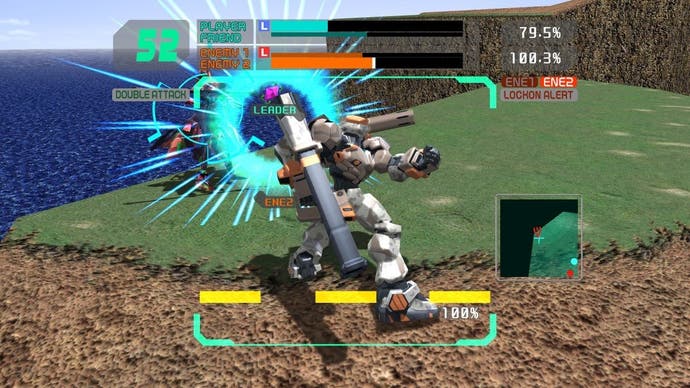Cyber Troopers Virtual-On Force
A force to be wrecking with.
The spare Turbo button is replaced with a target selector that switches between opponents, and to secure a lock-on you still have to either jump and quickly land or dash and fire a weapon. Which may sound confusing to the uninitiated, but the ebb and flow of Virtual-On combat is about keeping your opponent pressured, carefully observing their movement patterns and looking for opportunities to catch them off guard with your most potent attacks.
It takes a considerable amount of practice for everything to sink in, as there are many advanced techniques to learn, but once you've got down the basics it's more a case of finding a Virtuaroid that best complements your style of play.
There are 12 basic models to choose from, ranging from the classic Temjin all-rounder – complete with laser rifle and beam sword – to the new samurai-style Kagekiyo, who wields a Katana and Wakizashi. Force also sees the return of the sister Fei-Yen and Angelan units as well as the more heavy-duty Vox and Raiden. But rather than limited to a few custom paintjobs – as has been the case in the past – every Virtuaroid now has many selectable variations which alter their armaments, randomly unlocked in Mission mode for completing certain objectives.
What's more interesting is how Force accommodates those who want to play solo, because if your friends list is lacking in reliable co-pilots then you may have to make one yourself. This is handled in the AI Management screen, where you're encouraged to choose a Virtuaroid to complement your own. You're then presented with six intelligence characteristics, and while you'd expect a handful of intelligence points to help kick things off, for some reason you start with none.
This means you have to drag an utterly useless wingman through Arcade mode multiple times in order to scrape enough points together to get some kind of cognitive function going. Then once you start raking in the points and max out most of the attributes, your buddy will often steal the show and win the match single-handedly. As lopsided as this relationship can be, your AI won't be able to help in the online mode, as here you have to fend for yourself.

For the Rank Matches, you're randomly partnered with another player. But rather than a sensible matchmaking system where the two teams are kept as balanced as possible, I often found myself paired with another beginner while facing off against two highly-ranked veterans.
Thankfully, Player Matches can be browsed at your leisure. Lobbies set up by Japanese players have a habit of timing out before the match starts, but as compensation the netcode is stable once you're in and I never lagged out mid-match. The online competition is also fairly healthy for a game like this, with the leaderboards showing somewhere in the region of 6300 ranked players.
Whether you want Virtual-On Force is almost entirely dependent on how familiar you are with the series already. If you loved Tangram, then you may not relish the simplified controls and slower tempo, but the ability to team up with a friend certainly makes for a different and equally challenging experience. But if you've never had any love for the series before, then the unremarkable collection of single-player options will fail to change your outlook.
No matter which way you look at it, Force is a hardcore fighter hybrid which takes a certain type of gamer to appreciate its highly demanding yet deeply rewarding gameplay. When you consider it was originally released just a year after the PlayStation 2, it's hard not to be impressed that it still looks and plays so well today. My only regret is not having sampled it in arcade form, but I guess those cabinets have long since been beamed back to the future.
